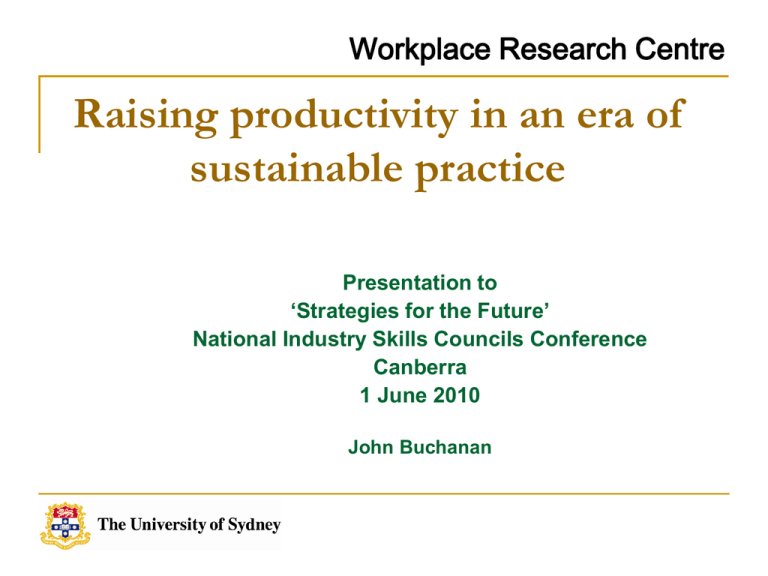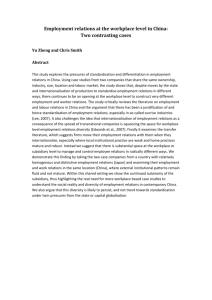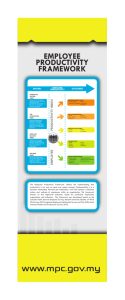Dr John Buchanan
advertisement

Workplace Research Centre Raising productivity in an era of sustainable practice Presentation to ‘Strategies for the Future’ National Industry Skills Councils Conference Canberra 1 June 2010 John Buchanan Workplace Research Centre Introduction How has productivity changed lately? How can workforce development help? Structure of today Workplace Research Centre Productivity - World trends (output per hours worked) - Australian trends - Multi-factor productivity (overall efficiency) Labour productivity (the human contribution) Workplace Research Centre Productivity- indicative world trends1 GDP per hour worked, Annual productivity 2007 US=100 growth rate 2000-2007 US Germany Japan 100 95 71 2.0 1.4 1.9 UK Canada Australia 89 86 82 2.3 1.1 1.6 Norway Ireland Greece 135 92 71 1.8 2.5 3.1 Workplace Research Centre Multi-factor productivity growth Australia2 Cycle MFP Rate % 1964/65 – 1968/69 1968/69 – 1973/74 1973/74 – 1981/82 1981/82 – 1984/85 1984/85 – 1988/89 1988/89 – 1993/94 1993/94 – 1998/99 1998/99 – 2003/2004 2003/2004 – 2007/08 1.3 1.6 1.1 0.8 1.0 2.3 1.1 1.1 -0.3 Workplace Research Centre Wage and labour productivity: Australia 1978 - 20083 200 Index: 1978:3 = 100 180 160 140 120 100 80 1980 1985 1990 1995 2000 Real wage Labour productivty (market sector) 2005 Workplace Research Centre Wages share of GDP: 1978 - 20083 64 Per cent of GDP 62 60 58 56 54 52 1980 1985 1990 1995 2000 Total wages as a % GDP 2005 Workplace Research Centre The workforce development challenge: rethinking labour supply and demand Labour supply (people in transition) Labour demand (jobs in transition) Workplace Research Centre Working life: key transitions4 PRIVATE HOUSEHOLDS EDUCATION SYSTEM LABOUR MARKET UNEMPLOYMENT RETIREMENT Workplace Research Centre 2. Analysis: Labour and Workforce Development5 Labour potential challenge 1: development On-the-job realisation challenge 2: deployment Systems of workforce development (skills ecosystem) Embodies blends of development and deployment Embedded in dynamics of labour market segmentation + macro flows of production and consumption Workplace Research Centre Guide to the day Reflecting on new directions Showcasing new initiatives Moving the beyond the ‘there is no alternative’ mindset of the last 30 years Workplace Research Centre References 1. 2. 3. 4. 5. L Mishel, J Bernstein and H Shierholz, The State of working America, Cornell Uni Press, Ithaca: 361 Australian Parliament, Inquiry into the level of productivity growth in the Australian economy, 28 April, 2010 (and Quiggin, J (2006), ‘Stories about Productivity’, Australian Bulletin of Labour, Vol 32, no 1 2006, pages 18 – 26. See also http://www.pc.au/research/productivity/estimates- trends/recentmovements. Material from ABS, A System of National Accounts, 2007 -08. Graph initially prepared by Bill Mitchell and reproduced by Serena Yu G Schmid’s notion of Transitional Labour Markets is summarised in ACIRRT, Australia at work: Just managaing?, Prentice Hall, Sydney, 1999 These ideas about workforce development are summarised, for example, in I Watson et al, Fragmented Futures: new challenges in working life, Federation Press, Sydney, 2003: Chapter 10.







